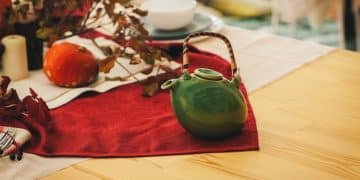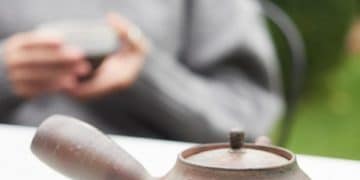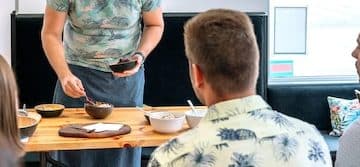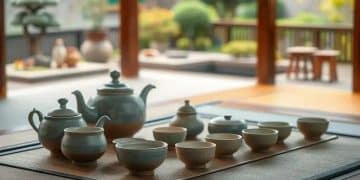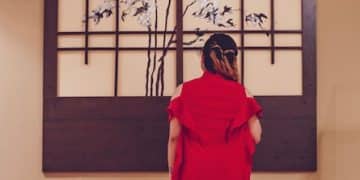Korean Tea Ceremony: A Beginner’s Guide for Tea Lovers in the US
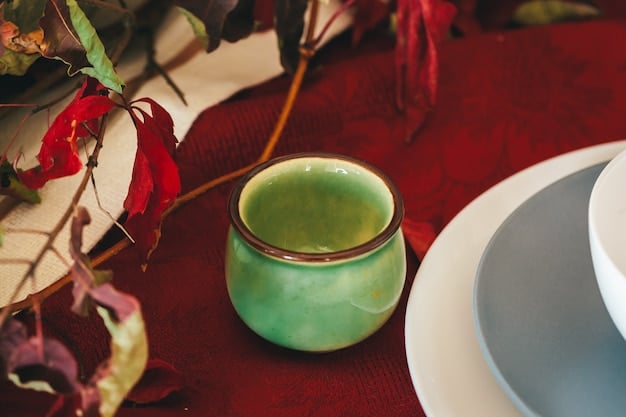
The Korean Tea Ceremony, or *darye*, is a beautiful and intricate tradition that embodies respect, harmony, and mindfulness. This step-by-step guide is designed for beginners in the US who want to learn how to perform and appreciate this unique cultural experience.
Interested in immersing yourself in Korean culture? The Korean Tea Ceremony: A Step-by-Step Guide for Beginners in the US offers a fascinating glimpse into a world of tradition, mindfulness, and exquisite etiquette. Let’s explore the art of *darye* together.
Understanding the Korean Tea Ceremony
The Korean Tea Ceremony, known as *darye* (茶禮) in Korean, is much more than just drinking tea. It’s a formal way of showing respect to guests, ancestors, and the tea itself. Dating back centuries, this ceremony emphasizes harmony, tranquility, and mindfulness.
There are two main types of Korean tea ceremonies: the formal royal court ceremony and the more casual ceremony practiced in homes. Both share core principles but differ in their level of formality and specific rituals.
The Philosophy Behind Darye
At its heart, the Korean tea ceremony is rooted in Confucian values of respect, harmony, and filial piety. Every action, from the way the tea is poured to how it is received, is imbued with meaning and intention.
- Respect: Showing deference to elders, guests, and ancestors.
- Harmony: Creating a peaceful and balanced environment.
- Mindfulness: Being present in the moment and appreciating the tea.
- Cleanliness: Maintaining a clean and tidy environment for the tea ceremony.
Understanding these principles can deepen your appreciation for the Korean tea ceremony and its cultural significance.
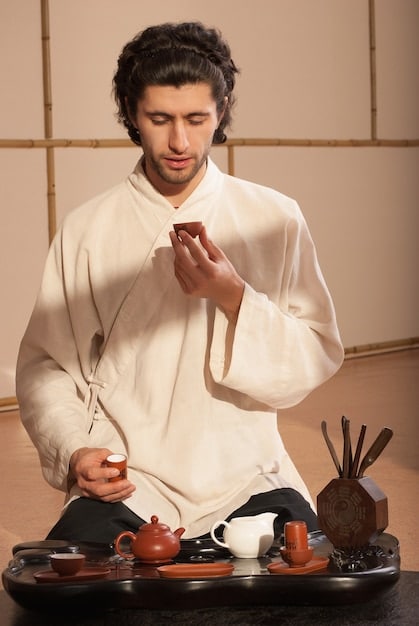
Participating in a Korean tea ceremony is a sensory experience that invites you to slow down, appreciate the present moment, and connect with others in a meaningful way.
In conclusion, the Korean Tea Ceremony, or Darye, embodies harmony, respect, and mindfulness. It offers a way to connect with Korean culture and traditions, emphasizing the importance of being present and showing consideration in every action.
Essential Teaware for a Korean Tea Ceremony
Having the right teaware is crucial for an authentic Korean tea ceremony experience. The specific items may vary depending on the formality of the ceremony, but some essentials include the teapot, teacups, and serving bowls.
Traditionally, Korean teaware is made from porcelain or pottery and is often decorated with subtle designs. The beauty of the teaware adds to the overall aesthetic and sensory experience of the ceremony.
Key Teaware Items
Here are some of the key teaware items you’ll need for a basic Korean tea ceremony:
- Teapot (Janjak): A small teapot, often made of porcelain or earthenware.
- Teacups (Chawan): Small, handleless cups designed to be held in both hands.
- Serving Bowl (S 숙우 sukwoo): Used to cool the water to the appropriate temperature.
- Tea Bowl Stand (받침 batchim): A coaster to hold the teacup.
Investing in a beautiful tea set can enhance your enjoyment of the Korean tea ceremony. Consider choosing pieces that reflect your personal style and appreciation for Korean aesthetics.
Selecting the right teaware is a crucial step in preparing for a Korean Tea Ceremony. The teaware not only enhances the aesthetic appeal but also plays a significant role in the ritual, reflecting the values of respect and mindfulness. Investing in quality, traditional pieces can greatly enrich the experience.
Choosing the Right Tea for Your Ceremony
The type of tea used in a Korean tea ceremony can vary depending on personal preference and the occasion. However, green tea is the most common choice, particularly first flush green tea known as *ujeon*.
Other popular options include roasted barley tea (boricha), corn tea (oksusu cha), and various herbal teas. Each tea offers a unique flavor profile and health benefits.
Popular Korean Teas
Here are some popular Korean teas you might consider for your tea ceremony:
- Ujeon: First flush green tea, known for its delicate flavor.
- Sejak: Second flush green tea, slightly more robust than ujeon.
- Boricha: Roasted barley tea, a common everyday tea in Korea.
- Oksusu Cha: Corn tea, a warm and comforting beverage.
When selecting a tea, consider the season and the preferences of your guests. Offering a variety of teas can also be a thoughtful gesture.
Choosing the right tea is essential for a Korean Tea Ceremony as it enhances the overall experience with its unique flavors and health benefits. Whether opting for traditional green teas like Ujeon or exploring alternatives like Boricha or Oksusu Cha, consider the season and your guests’ preferences to provide a thoughtful and enjoyable ceremony.
Step-by-Step Guide to Performing a Korean Tea Ceremony
While the specific steps may vary, this guide offers a basic framework for performing a Korean tea ceremony in the US. Remember to approach the ceremony with respect, mindfulness, and a genuine appreciation for the tradition.
Before you begin, ensure that you have all the necessary teaware and tea prepared. Create a clean and peaceful environment, free from distractions.
The Ceremony Steps
- Prepare the Teaware: Warm the teapot and teacups with hot water.
- Prepare the Tea: Add tea leaves to the teapot. The amount will vary based on the type of tea.
- Heat the Water: Heat water to the appropriate temperature for your chosen tea.
- Pour the Water: Pour the hot water into the teapot.
- Steep the Tea: Allow the tea to steep for the recommended time.
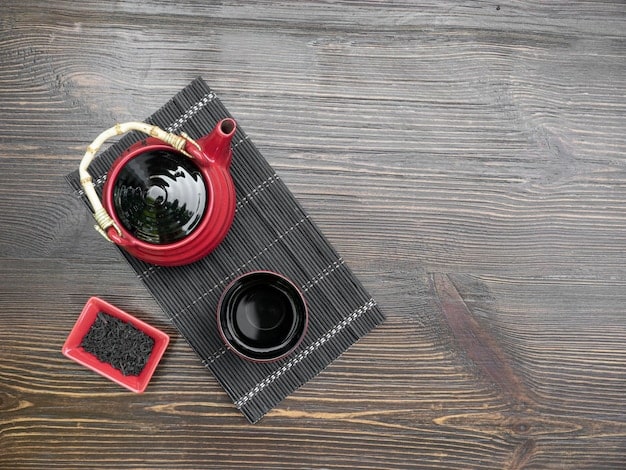
Once the tea is steeped, you’re ready to serve your guests. Pour the tea with care, and present the teacups with both hands.
Performing a Korean Tea Ceremony involves careful preparation and precise steps. By following the essential stages, from warming the teaware to steeping and serving the tea, one can create an authentic and respectful experience, reflecting the mindfulness and harmony central to the tradition.
Tea Etiquette: Dos and Don’ts
Understanding the etiquette of the Korean tea ceremony is essential for demonstrating respect and appreciation. Here are some important dos and don’ts to keep in mind.
When receiving a cup of tea, accept it with both hands. This shows respect and acknowledgment. Take small sips and savor the flavor.
Important Etiquette Tips
Here are some key etiquette tips to observe during a Korean tea ceremony:
- Do: Accept the teacup with both hands.
- Do: Take small sips and savor the tea.
- Do: Offer compliments on the tea and teaware.
- Don’t: Speak loudly or engage in distracting behavior.
By following these simple guidelines, you can ensure that your participation in the Korean tea ceremony is respectful and enjoyable for everyone involved.
Proper tea etiquette is vital in a Korean Tea Ceremony, reflecting respect and appreciation. By adhering to these guidelines, such as accepting the teacup with both hands and avoiding loud or distracting behavior, participants can ensure a respectful and enjoyable experience for everyone.
Adapting the Ceremony for a US Audience
While it’s important to respect the traditions of the Korean tea ceremony, it’s also okay to adapt certain aspects to suit a US audience. Focus on the core principles of respect, harmony, and mindfulness while making the ceremony accessible and enjoyable for your guests.
Consider explaining the significance of the rituals and the meaning behind the actions. This can help your guests appreciate the cultural context of the ceremony.
Tips for Hosting a Ceremony in the US
Here are some tips for adapting the Korean tea ceremony for a US audience:
- Provide Background: Share information about the history and meaning of the ceremony.
- Offer Explanations: Explain the significance of each action and ritual.
- Be Flexible: Allow for questions and adjustments to suit your guests’ comfort levels.
- Emphasize Enjoyment: Focus on creating a relaxed and welcoming atmosphere.
By striking a balance between tradition and adaptation, you can create a meaningful and memorable experience for everyone involved.
Adapting the Korean Tea Ceremony for a US audience involves balancing respect for tradition with the need to make the ceremony accessible and enjoyable. Providing background information, explaining rituals, and being flexible allows for a meaningful and engaging experience that respects both the tradition and the audience.
| Key element | Brief Description |
|---|---|
| 🍵 Preparing Tea | Select the type of tea, heat the water and steep the tea in the teapot for some minutes. |
| 🤝 Serving Tea | Hold the teacup with both hands to show respect and offer it to the guests. |
| 🤔 Observarions | Follow the rules during the tea ceremony. |
| 🎉 Adaptation | Adapt the ceremony depending on your audience. |
Frequently Asked Questions
▼
The Korean Tea Ceremony is a traditional practice that involves preparing and serving tea to show respect, harmony, and mindfulness. It’s a cultural art that embodies Korean values and etiquette.
▼
The key elements include the correct teaware, quality tea (usually green tea), and an environment that promotes respect and composure. The way the tea is offered and received is also essential.
▼
Yes, you can adapt the tea ceremony by explaining the rituals and their significance. It’s important to maintain the core values while accommodating the comfort and understanding of those unfamiliar.
▼
Green tea is usually the most common choice since it is the traditional type. But you can use other kinds of tea such as roasted barley, or even corn tea depending on the season and the audience.
▼
During the tea ceremony, it’s crucial to accept the teacup with both hands and offer compliments on the tea. Avoid speaking loudly or behaving distractingly to maintain a respectful atmosphere.
Conclusion
The Korean Tea Ceremony is a beautiful tradition that offers a glimpse into Korean culture and values. By following this step-by-step guide, beginners in the US can experience the beauty and tranquility of *darye* while showing respect for the tradition and its rich history.

